The Radeon R9 280X Review: Feat. Asus & XFX - Meet The Radeon 200 Series
by Ryan Smith on October 8, 2013 12:01 AM ESTCompute
Jumping into compute, as with our synthetic benchmarks we aren’t expecting too much new here. Outside of DirectCompute GK104 is generally a poor compute GPU, which makes everything very easy for the Tahiti based 280X. At the same time compute is still a secondary function for these products, so while important the price cuts that go with the 280X are not quite as meaningful here.
As always we'll start with our DirectCompute game example, Civilization V, which uses DirectCompute to decompress textures on the fly. Civ V includes a sub-benchmark that exclusively tests the speed of their texture decompression algorithm by repeatedly decompressing the textures required for one of the game’s leader scenes. While DirectCompute is used in many games, this is one of the only games with a benchmark that can isolate the use of DirectCompute and its resulting performance.
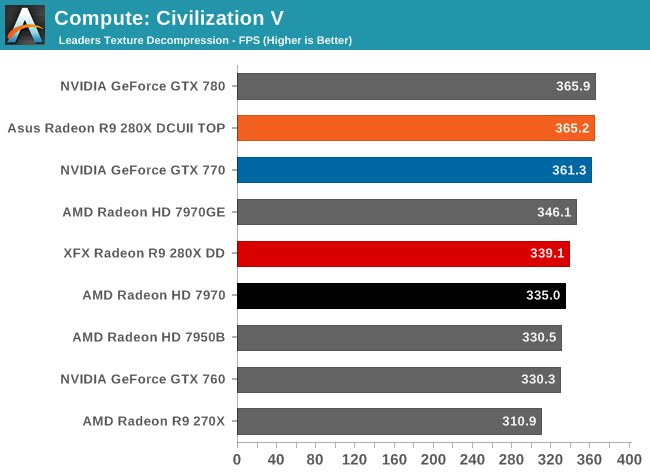
With Civilization V we’re finding that virtually every high-end GPU is running into the same bottleneck. We’ve reached the point where even GPU texture compression is CPU-bound.
Our next benchmark is LuxMark2.0, the official benchmark of SmallLuxGPU 2.0. SmallLuxGPU is an OpenCL accelerated ray tracer that is part of the larger LuxRender suite. Ray tracing has become a stronghold for GPUs in recent years as ray tracing maps well to GPU pipelines, allowing artists to render scenes much more quickly than with CPUs alone.
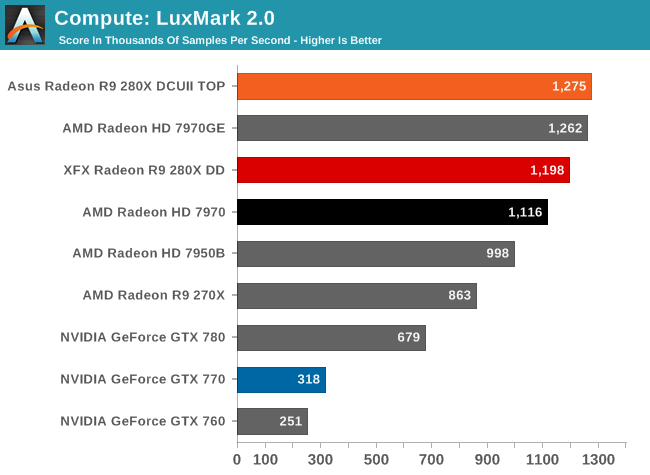
AMD simply rules the roost when it comes to LuxMark, so the only thing close to 280X here are other Tahiti parts.
Our 3rd compute benchmark is Sony Vegas Pro 12, an OpenGL and OpenCL video editing and authoring package. Vegas can use GPUs in a few different ways, the primary uses being to accelerate the video effects and compositing process itself, and in the video encoding step. With video encoding being increasingly offloaded to dedicated DSPs these days we’re focusing on the editing and compositing process, rendering to a low CPU overhead format (XDCAM EX). This specific test comes from Sony, and measures how long it takes to render a video.
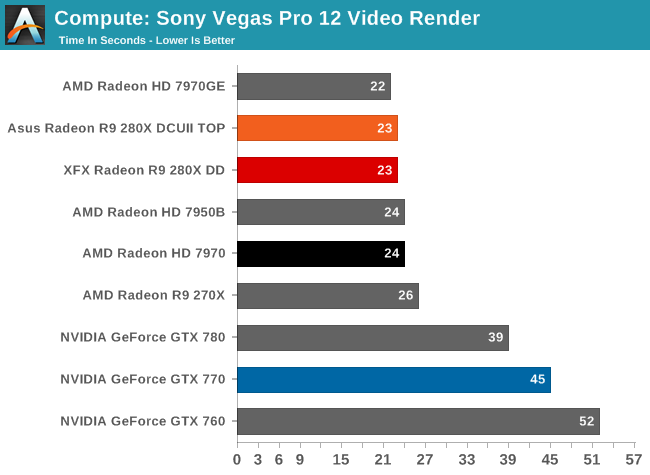
Again AMD’s strong compute performance shines through, with 280X easily topping the chart.
Our 4th benchmark set comes from CLBenchmark 1.1. CLBenchmark contains a number of subtests; we’re focusing on the most practical of them, the computer vision test and the fluid simulation test. The former being a useful proxy for computer imaging tasks where systems are required to parse images and identify features (e.g. humans), while fluid simulations are common in professional graphics work and games alike.
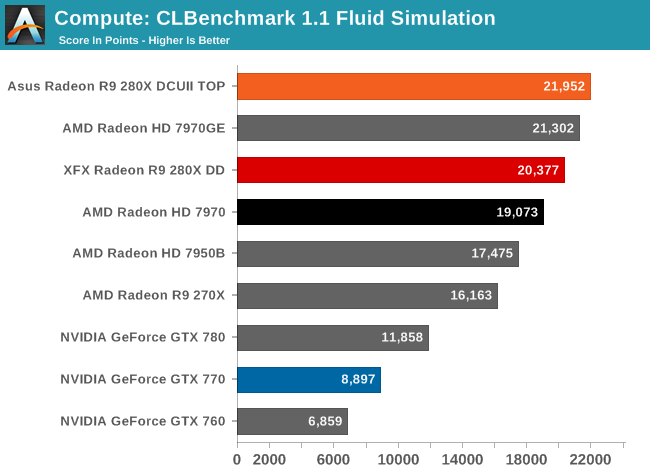
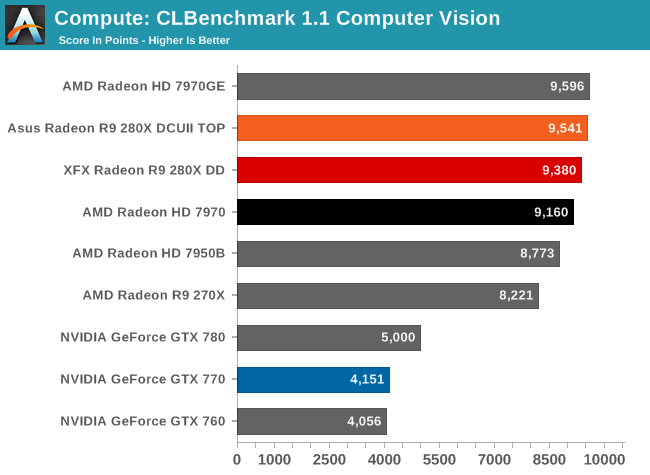
Despite the significant differences in these two workloads, in both cases 280X comes out easily on top.
Moving on, our 5th compute benchmark is FAHBench, the official Folding @ Home benchmark. Folding @ Home is the popular Stanford-backed research and distributed computing initiative that has work distributed to millions of volunteer computers over the internet, each of which is responsible for a tiny slice of a protein folding simulation. FAHBench can test both single precision and double precision floating point performance, with single precision being the most useful metric for most consumer cards due to their low double precision performance. Each precision has two modes, explicit and implicit, the difference being whether water atoms are included in the simulation, which adds quite a bit of work and overhead. This is another OpenCL test, as Folding @ Home has moved exclusively to OpenCL this year with FAHCore 17.

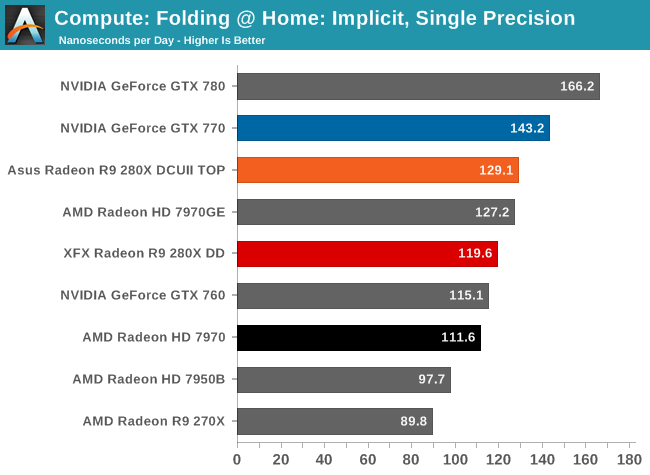

Depending on the mode and the precision, we can have wildly different results. The 280X does well in FP32 explicit, for example, but in implicit mode the 280X is now caught between the GTX 770 and GTX 760. But if we move to double precision then AMD’s native ¼ FP64 execution speed gives them a significant advantage here.
Wrapping things up, our final compute benchmark is an in-house project developed by our very own Dr. Ian Cutress. SystemCompute is our first C++ AMP benchmark, utilizing Microsoft’s simple C++ extensions to allow the easy use of GPU computing in C++ programs. SystemCompute in turn is a collection of benchmarks for several different fundamental compute algorithms, as described in this previous article, with the final score represented in points. DirectCompute is the compute backend for C++ AMP on Windows, so this forms our other DirectCompute test.
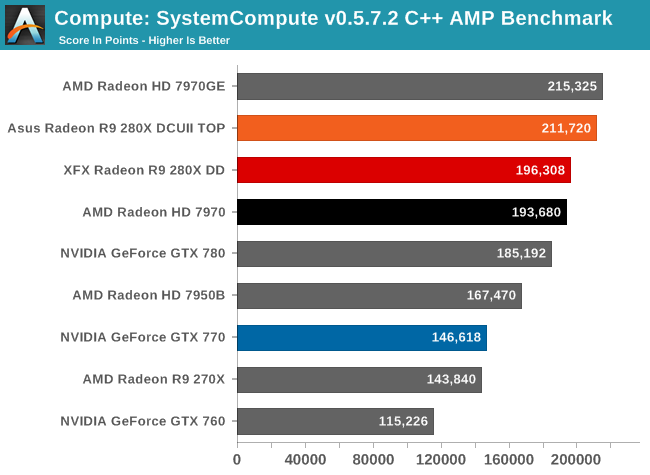
Although not by any means a blowout, yet again the 280X vies for the top here. When it comes to compute, the Tahiti based 280X is generally unopposed by anything in its price range.










151 Comments
View All Comments
Sabresiberian - Wednesday, October 9, 2013 - link
I don't think any current game dev can complain about the top API suites today when they don't even take advantage of the hardware available.Kudos to those beginning to take advantage of multiple cores in CPUs, but what you are doing clearly isn't enough. It is ridiculous that a 6-core hyperthreaded CPU doesn't provide a significant performance boost in any of today's games over a 4-core CPU without hyperthreading, and we've had them for 5 years now, so the hardware has been around longer than the development cycle of most games and should be taken advantage of by now. This is not the fault of Direct3D or OpenGL.
I'm excited about the possibilities of Mantle, but skeptical of the results. We'll see.
AnnihilatorX - Thursday, October 10, 2013 - link
On the page about TrueAudioshould it read:
Tensilica’s audio DSPs are task-specific programmable hardware, somewhere between fixed [s]function[s] and fully programmable in function,
?
Hixbot - Friday, October 11, 2013 - link
Well another gen of graphics cards and no serious change in performance per dollar. The past 2 years of PC hardware development have been BORING. Why do the big players refuse to compete seriously?fantasysportsguy - Saturday, October 12, 2013 - link
So if you have an HD 7850, what is the upgrade path?SirKronan - Sunday, October 13, 2013 - link
"Of course the fact that AMD also needs to get rid of the 7000 series at the same time isn’t going to do them any favors. There’s no getting around the fact that similar 7000 series products are going to be equal to or cheaper than 200 series products, at least for the immediate launch. "This prediction turned out to be WRONG. It is what I was expecting as well, but the opposite happened. Every 7970 on just about every store I shop at seems to have JUMPED by about $80.
What the heck??
Compuservant - Monday, October 14, 2013 - link
You do realize there is another Asus R9 280 GPU. The Asus R9 280X Matrix Platinum is their top model in this specific range and ships with a core overclock at 1,100mhz. The GDDR5 memory has also been overclocked to 1,600mhz (6.4Gbps effective).Aside from the massive overclock, Matrix R9 280X graphics cards have exclusive ROG VGA Hotwire technology built in for even more overclocking headroom. By wiring the Matrix R9 280X’s VGA Hotwire terminals to header connections on the motherboard, users are able to overvolt right away.
In conjunction with the TweakIt utility and the plus and minus buttons fitted to some ASUS ROG motherboards, VGA Hotwire puts overvolting adjustments at users’ fingertips – so they can gradually and safely increase power for higher speeds and smoother gaming. With Matrix R9 280X cards, TweakIt offers a wider voltage-modulation range than ever before and it’s also possible to immediately activate the dual 100mm fans — enabling maximum airflow and instant cooling at the touch of a button.
Most of above was cut and paste (sorry), but do you know of a supported motherboard for the i7 4770k CPU?
I think I read that the new cards can do crossfire without a bridge/connector. Imagine the performance for $650 or so, for 2 280x Matrix Platinums!
Death666Angel - Tuesday, October 15, 2013 - link
I know the article is older, but I just got to it.In the overclocking section, you write:
"The Asus card meanwhile was good for 40MHz more, for a 4% base/4% boost overclock, while its memory could do an additional 800MHz (13%)."
But it base clock is factory overclocked at 6.4GHz and it achieves a 6.8GHz clock in your test, so it is "just" a 400 MHz boost.
Dragonheart.BY - Thursday, November 14, 2013 - link
Is there any info about 280 non-x? Will it be released at all?inFormal - Wednesday, December 18, 2013 - link
I m trying to find (& order) an Asus R9 280x DCII 3GB (Tahiti XTL) but everywhere i looked they're "OUT OF STOCK" ... what the fudge ? Don t they know that i am prone to do useless it shopping during December ?dsmogor - Friday, January 24, 2014 - link
Can SteamOS access that as well (by having Mantle somewhat integrated with OGL) we would have a winninng arch/software combination.